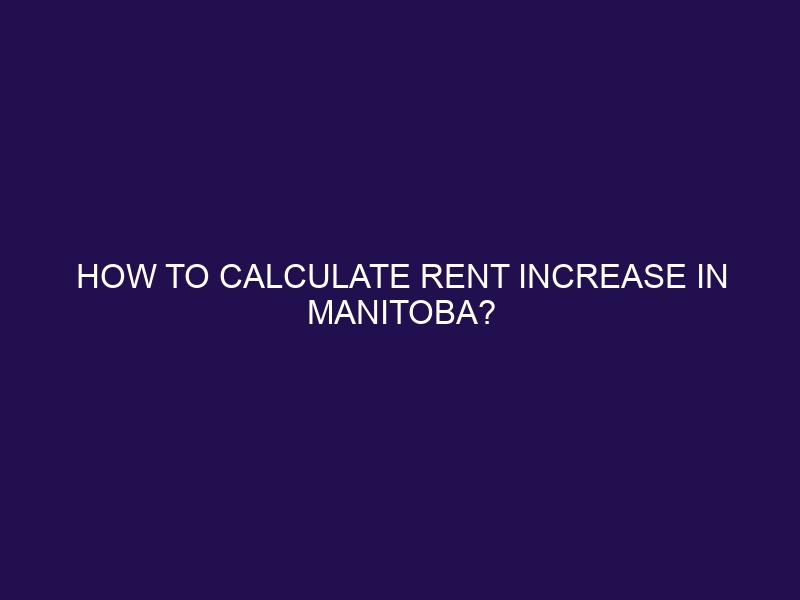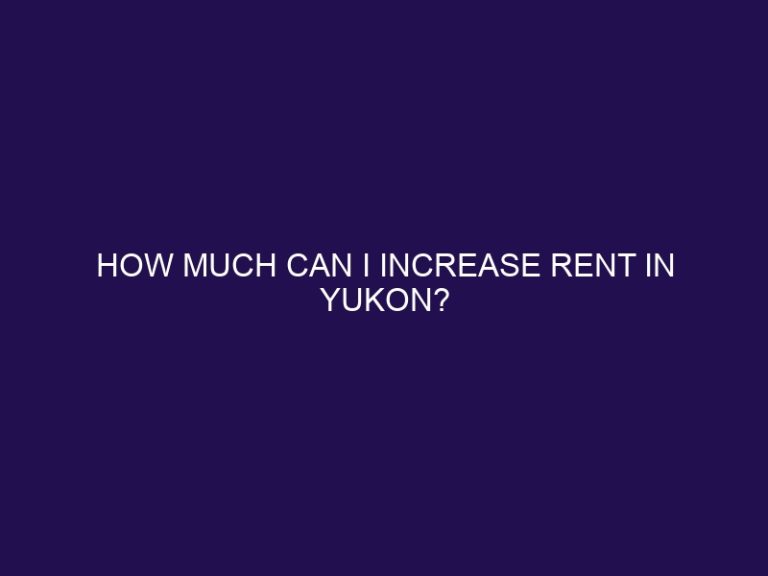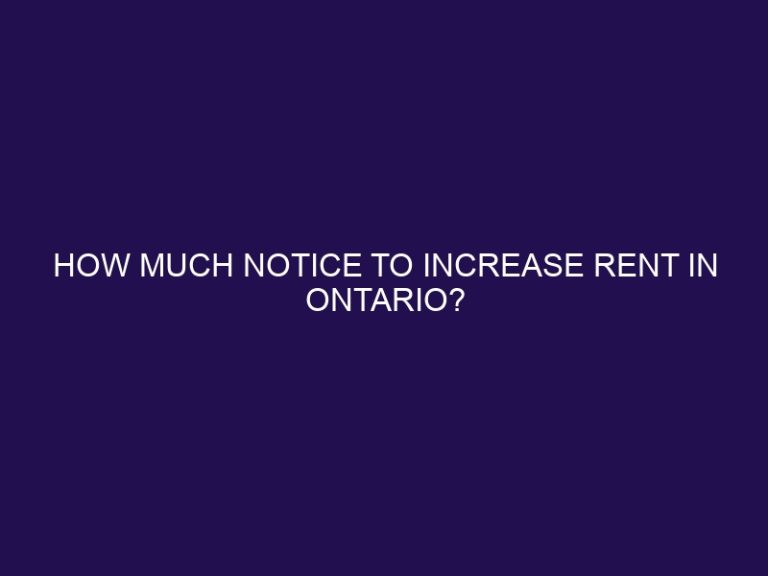How to calculate rent increase in Manitoba?
.jpg)
Rent increase is a common concern for both landlords and tenants in Manitoba. Understanding the regulations and calculations involved is crucial to ensure a fair and legal process. This article provides an overview of rent increase in Manitoba, including the legal regulations, calculation methods, factors to consider, and tenant rights.
Rent increase refers to the adjustment in the amount a landlord charges for rental properties. In Manitoba, there are specific legal regulations that govern rent increase to protect the rights and interests of both landlords and tenants. These regulations cover topics such as rent increase guidelines, notice requirements, and exemptions.
To calculate rent increase in Manitoba, there are different methods available. One method is based on a percentage increase, where the rent is adjusted by a specific percentage set by the Residential Tenancies Branch. Another method involves a fixed amount increase, where the rent is increased by a predetermined fixed amount.
Several factors need to be considered before implementing a rent increase. These include market rent and comparable units, maintenance and upgrades done to the property, and the affordability of the tenant in the current rental market.
Tenants have certain rights and recourse if they believe a rent increase is unfair or unlawful. They have the right to challenge a rent increase and can seek mediation or dispute resolution services to resolve any conflicts or disputes that may arise.
By understanding the regulations, calculations, and considerations involved in rent increase in Manitoba, both landlords and tenants can navigate this process effectively and ensure a fair and transparent rental agreement.
Key takeaways:
- Understanding rent increase in Manitoba: Familiarize yourself with the legal regulations, guidelines, and notice requirements for rent increase in Manitoba to ensure compliance and avoid any conflicts with tenants.
- Calculating rent increase in Manitoba: Rent increases can be calculated based on either a percentage increase or a fixed amount increase. Consider the local rental market, maintenance and upgrades, and tenant affordability before implementing a rent increase.
- Tenant rights and recourse: Tenants have the right to challenge rent increases and can resort to mediation and dispute resolution methods if necessary. Ensure you are aware of tenants’ rights and provide appropriate recourse options.
Overview of Rent Increase in Manitoba
Overview of Rent Increase in Manitoba
Rent increase in Manitoba is regulated by the Residential Tenancies Branch. The Residential Tenancies Branch provides an overview of the rules and regulations regarding rent increases in the province. Landlords in Manitoba can only increase rent once a year, as per the guidelines set by the Residential Tenancies Branch. They must provide proper notice to the tenants and ensure that the increase is within the allowable percentage.
For the year 2021, the allowable rent increase in Manitoba is 1.6%. Landlords need to inform their tenants in writing at least three months in advance before the rent increase takes effect. This ensures that tenants have ample time to prepare for the change in their rental expenses. If tenants find the rent increase to be unreasonable, they have the right to dispute it through the Residential Tenancies Branch. This allows for a fair and just resolution to any disputes that may arise regarding rent increases.
In 2018, Manitoba took a proactive stance in protecting tenants from unreasonable rent increases. The implementation of new legislation aimed at providing stability in the rental market and preventing tenants from being burdened by excessive rent hikes. This approach reflects the government’s commitment to affordable housing for all residents of Manitoba. By creating a fair and balanced system for rent increases, both tenants and landlords can benefit from a more harmonious rental environment.
What is Rent Increase?
What is Rent Increase?
Rent increase refers to the adjustment made to the rent amount charged by a landlord to a tenant.
What is Rent Increase? It is a legal process that allows landlords to raise the rent periodically. Rent increases typically occur annually or as specified in the rental agreement. The purpose of rent increase is to account for inflation and to ensure that rental income keeps pace with the rising costs of maintaining the property. Rent increase guidelines vary by jurisdiction, so it’s important to be familiar with the local laws and regulations to understand the process and limitations of rent increases.
Legal Regulations for Rent Increase in Manitoba
Rent increase regulations in Manitoba are essential to understand for both landlords and tenants. In this section, we will dive into the legal framework governing rent increases in Manitoba. From rent increase guidelines to notice requirements and exemptions, we’ll cover it all. So if you’re looking to navigate the intricacies of rent increase in Manitoba, hang tight because we’ve got you covered.
Rent Increase Guidelines
Rent Increase Guidelines in Manitoba are essential to adhere to so as to ensure fairness and compliance with legal regulations. These guidelines precisely delineate the maximum permissible percentage for rent increment and the notice requirements for landlords. It is of utmost importance to accurately calculate the rent increase, whether it be through a percentage hike or a fixed amount augmentation, while considering factors such as market rent, comparable units, maintenance, upgrades, and tenant affordability. Tenants possess rights and avenues for recourse if they perceive the rent increase to be unjustified. Mediation and dispute resolution processes are in place to resolve any conflicts that arise between landlords and tenants. Adhering to the rent increase guidelines can contribute to upholding a well-balanced and transparent rental market in Manitoba.
Notice Requirements for Rent Increase
- Review Rent Increase Guidelines: Familiarize yourself with the notice requirements for rent increase in Manitoba to ensure compliance.
- Prepare Written Notice: Create a written notice that meets the specific requirements and informs tenants about the upcoming rent increase.
- Include Relevant Information: Ensure that the notice includes all the necessary details required by the notice requirements for rent increase, such as the effective date of the increase, the new rent amount, and the reason for the increase.
- Provide Adequate Notice Period: Give tenants proper notice, which is typically three full rental periods, as mandated by the notice requirements for rent increase in Manitoba, before the rent increase takes effect.
- Deliver Notice: Serve the notice directly to the tenant, either in person or by certified mail, as outlined in the notice requirements for rent increase.
- Keep Documentation: Maintain a copy of the notice and any proof of delivery as per the notice requirements for rent increase for your records.
By adhering to these notice requirements for rent increase in Manitoba, landlords can implement rent increases within the legal framework, ensuring transparency and fairness for both parties involved.
Exemptions to Rent Increase Guidelines
|
There are certain exemptions to the rent increase guidelines in Manitoba that landlords should be aware of. |
|
|
They include: |
|
|
1. Rent Control Exemption: |
Units that were built after February 28, 1991, are exempt from rent control. Landlords are allowed to set and increase the rent at their discretion. |
|
2. Rent-Geared-to-Income (RGI) Housing Exemption: |
Units that are part of a government-subsidized RGI program are exempt from rent increase guidelines. The increase is determined by the program’s rules and regulations. |
|
3. Long-Term Tenancies Exemption: |
Units where the tenant has lived continuously for over 20 years are exempt from rent increase guidelines. The increase must be reasonable and fair. |
|
4. Non-Residential Tenancies Exemption: |
Tenancies that are non-residential, such as commercial or industrial properties, are exempt from rent increase guidelines. |
How to Calculate Rent Increase in Manitoba?
Looking to determine how to calculate rent increase in Manitoba? In this section, we’ll uncover the step-by-step methods for calculating rent increases based on percentage and fixed amount increases. Whether you’re a tenant or a landlord, understanding these calculations is crucial for navigating the rental market in Manitoba. Get ready to crunch the numbers and gain a clearer understanding of the guidelines surrounding rent adjustments in this province.
Calculation based on Percentage Increase
To calculate rent increase in Manitoba based on percentage, you will need to follow specific guidelines. Here is a breakdown of the calculation process:
| Step 1: | Determine the current rent amount |
| Step 2: | Calculate the maximum allowable percentage increase based on the Rent Increase Guideline set by the Residential Tenancies Branch |
| Step 3: | Multiply the current rent amount by the maximum allowable percentage increase to determine the maximum allowable increase in dollars |
| Step 4: | Add the maximum allowable increase in dollars to the current rent amount to get the new rent amount |
By following these steps, you can accurately calculate the rent increase in Manitoba using the percentage method. Remember to always adhere to the regulations and guidelines provided by the Residential Tenancies Branch.
Calculation based on Fixed Amount Increase
To calculate rent increase in Manitoba based on a fixed amount increase, follow these steps:
1. Determine the current monthly rent amount for the rental unit.
2. Decide on the fixed amount increase you want to implement, ensuring it does not exceed the maximum allowable amount set by the Rent Increase Guidelines.
3. Add the fixed amount increase to the current monthly rent amount.
4. The resulting sum will be the new monthly rent after the fixed amount increase.
For example, if the current monthly rent is $800 and you want to apply a fixed amount increase of $50, the new monthly rent would be $850.
Please note that it is important to familiarize yourself with the Rent Increase Guidelines and regulations specific to Manitoba to ensure compliance.
Factors to Consider before Implementing Rent Increase
Before implementing a rent increase, it’s crucial to consider various factors that can greatly impact the decision. In this section, we’ll explore these key factors, from market rent and comparable units to the importance of maintenance and upgrades. We’ll also delve into the tenants’ affordability and the current state of the rental market. By understanding and evaluating these aspects, landlords can make informed decisions that strike a balance between fair returns and tenant satisfaction.
Market Rent and Comparable Units
Market rent and comparable units are two crucial aspects to take into account when implementing a rent increase in Manitoba. It is important to keep these points in mind:
- Market Rent: It is essential to conduct thorough research on the prevailing rental market in your area. This research will allow you to determine the average rent for similar units. By doing so, you will be able to assess whether your proposed increase aligns with the market rates.
- Comparable Units: To gain a better understanding of how your rental property competes in the market, it is advisable to compare it with similar units in terms of size, location, amenities, and condition.
- Maintenance and Upgrades: Additionally, consider any recent upgrades or improvements you have made to the unit. These enhancements can justify a higher rent increase as they contribute to increasing the value of the property.
- Tenant Affordability and Rental Market: It is crucial to take into account the financial circumstances of your tenants and the overall affordability of the rental market. Excessive rent increases might put a financial strain on your tenants and potentially lead to tenant turnover.
By carefully considering these factors, you can ensure that your rent increase is fair and reasonable for both you and your tenants.
Maintenance and Upgrades
Maintenance and upgrades are essential considerations when implementing a rent increase in Manitoba. Landlords must evaluate the condition of the rental property and invest in necessary repairs and maintenance to justify a rent increase. Here are some crucial points to keep in mind:
- Maintenance: Regular upkeep and repairs are necessary to ensure the property remains in good condition.
- Upgrades: Enhancements and improvements should be made to the property to add value and enhance tenant satisfaction.
- Budgeting: It is important to plan and allocate a budget for maintenance and upgrades to prevent unexpected expenses.
- Fairness: The rent increase should be reasonable and justified based on the maintenance and upgrades performed.
- Communication: Tenants should be informed about the ongoing maintenance and upgrades and how they contribute to the rental value.
- Documentation: Keeping records of maintenance work and any upgrades done is crucial to support the rent increase.
Tenant Affordability and Rental Market
Consider tenant affordability and the rental market when implementing a rent increase in Manitoba. Remember these important factors:
- Market Rent and Comparable Units: Conduct research on the current rental market and compare your rental unit to similar properties. This will ensure that your proposed rent increase aligns with market rates.
- Maintenance and Upgrades: Take into account any recent maintenance or upgrades done to the rental unit. If significant improvements have been made, it might justify a higher rent increase.
- Tenant Affordability: Consider the financial circumstances of your tenants. A large rent increase could burden them, potentially resulting in vacancies or difficulties in collecting rent.
To maintain profitability while ensuring tenant satisfaction, carefully consider any rental increase and openly communicate with your tenants about the reasons behind the proposed increase.
Tenant Rights and Recourse
As a tenant in Manitoba, understanding your rights and available recourse when it comes to rent increase is crucial. In this section, we’ll dive into the tenant’s right to challenge rent increase, exploring the options available to you if you believe the rent hike is unfair. We’ll examine the importance of mediation and dispute resolution in resolving any conflicts that may arise between tenants and landlords. So, let’s explore your rights and how you can navigate these situations with confidence.
Tenant’s Right to Challenge Rent Increase
When facing a rent increase in Manitoba, tenants have the Tenant’s Right to Challenge Rent Increase if they believe it to be unfair or unreasonable. The rental agreement outlines the proper procedures for disputing the increase, and tenants should adhere to these guidelines to protect their rights. Mediation and dispute resolution services are available to assist tenants in resolving their issues with landlords. It is essential for tenants to understand their rights and take appropriate action if they believe a rent increase is unjustified. Fun fact: In Manitoba, landlords are required to provide tenants with a written notice of rent increase at least three months prior to the effective date.
Mediation and Dispute Resolution
When it comes to mediation and dispute resolution in Rent Increase Cases in Manitoba, mediation and dispute resolution play a crucial role in helping both tenants and landlords understand their rights and options. Mediation and dispute resolution provide an effective way to resolve conflicts and find a mutually satisfactory solution. In cases where the initial attempts of mediation and dispute resolution do not work, tenants have the right to challenge the rent increase through a formal dispute resolution process. This process, which involves mediation and dispute resolution, provides an opportunity for both parties to present their arguments and evidence before an independent adjudicator. To ensure a fair outcome in the mediation and dispute resolution process, it is crucial for both tenants and landlords to familiarize themselves with the relevant regulations and procedures.
Some Facts About How To Calculate Rent Increase in Manitoba:
- ✅ The 2020 rent increase guideline for Manitoba is set at 2.4%, slightly higher than the previous year. (Source: Landlord Talking)
- ✅ The rent increase guideline in Manitoba is lower than that of British Columbia (2.6%) and higher than that of Ontario (2.2%) for 2020. (Source: Landlord Talking)
- ✅ Landlords in Manitoba are required to provide written notice at least three months prior to the rent increase taking effect, using an approved Notice of Rent Increase form from the Residential Tenancies Branch. (Source: Landlord Talking)
- ✅ Rent can generally only be increased once per year in Manitoba. (Source: Landlord Talking)
- ✅ The rent increase guideline in Manitoba applies to most residential rentals, except for specific units and buildings based on certain criteria. (Source: Landlord Talking)
Frequently Asked Questions
What is the annual rent increase guideline in Manitoba?
The annual rent increase guideline in Manitoba for 2020 is 2.4%. This percentage is slightly higher than the previous year. It is determined based on the average annual change in the consumer price index and is rounded to one decimal place. However, the maximum permitted rent increase must be within the inflation-control target range set by the Bank of Canada, which is currently between one and three percent.
How is the annual rent increase guideline calculated in Manitoba?
The calculation for the annual rent increase guideline in Manitoba is based on the average of the 12 monthly consumer price indexes for the 12-month period ending on June 30 of the previous year, divided by the average of the 12 monthly consumer price indexes for the preceding 12-month period. The result is expressed as a percentage and rounded to one decimal place. For more detailed information on the calculation, you can visit the Manitoba Residential Tenancies Branch website.
Can landlords increase the rent more than once a year in Manitoba?
No, in Manitoba, rent can generally only be increased once per year. Landlords must provide written notice to the tenants at least three months prior to the rent increase taking effect. This notice should be given using an approved Notice of Rent Increase form from the Residential Tenancies Branch. However, landlords can apply for a larger increase if there is evidence that the guideline amount will not cover an increase in costs.
Are there any exceptions to the rent increase guideline in Manitoba?
Yes, there are exceptions to the rent increase guideline in Manitoba. The guideline applies to most residential rentals, but it does not apply to units renting for $1,545.00 or more per month as of December 31, 2019, personal care homes, approved rehabilitated rental units, new buildings less than 15 years old (occupied after April 9, 2001), and new buildings less than 20 years old (occupied after March 7, 2005). These exceptions have their own specific regulations regarding rent increases.
How can I contact the Manitoba Residential Tenancies Branch for more information?
If you need more information or have specific questions regarding rent increases in Manitoba, you can contact the Manitoba Residential Tenancies Branch. They can provide you with guidance and assistance regarding residential rent regulations. You can find their contact information on their official website or contact them directly through phone or email.
Can I seek legal advice on rent increase matters in Manitoba?
Yes, if you are facing issues or need legal advice regarding rent increases in Manitoba, it is recommended to consult with a legal professional familiar with local tenancy laws. They can provide you with personalized advice based on your specific situation and help you understand your rights and obligations as a tenant.







